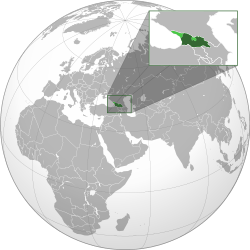Georgia (nasyon)
Appearance
- Manunungod an artikulong ini sa bansa. Para sa estado kan U.S., hilingon an Georgia (estado kan U.S.).
Georgya Tagboan: 42°00′N 43°30′E / 42.000°N 43.500°E
| Georgia | |
|---|---|
 Mga lugar sa irarom kan Georgian ipinapahiling sa kulay na dark green; asin an mga lugar na mayo sa kontrol kaini sa kulay na light green | |
 | |
| Kapitolyo and Pinakadakulang Syudad | Tbilisi 41°43′N 44°47′E / 41.717°N 44.783°E |
| Opisyal na mga tataramon | Georgian (nationwide) Abkhazian (Abkhazian AR)[1][2] |
| Mga etnikong grupo (2014[a]) | 86.8% Georgians 6.2% Azerbaijanis 4.5% Armenians 2.8% other |
| Relihiyon | Georgian Orthodox Church |
| Demonym | Georgian |
| Gobyerno | Unitary parliamentary Republikang Konstitusyonal |
| Salome Zurabishvili | |
| Irakli Kobakhidze | |
| Mamuka Bakhtadze[3] | |
| Lehistratura | An Parliament |
| An historya kan pagbuo | |
| 13th c. BC–580 AD | |
| 786–1008 | |
| 1008 | |
| 1463–1810 | |
12 September 1801 | |
26 May 1918 | |
| 25 February 1921 | |
9 April 1991 25 December 1991 | |
| 24 August 1995 | |
| Area | |
• Total | 69,700 km2 (26,900 sq mi) (119th) |
| Populasyon | |
• 2018 tantya | 3,729,600[a][4] (131st) |
• 2014 Sensus | 3,713,804[a][5] |
• Densidad | 53.5/km2 (138.6/sq mi) (137th) |
| GDP (PPP) | 2018 tantya |
• Kabuuhan | $43.037 billion[6] (116th) |
• Per capita | $11,600[6] (105th) |
| GDP (nominal) | 2018 tantya |
• Kabuuhan | $16.716 billion[6] (121st) |
• Per capita | $4,505[6] (108th) |
| Gini (2016) | Plantilya:IncreaseNegative 36.5[7] medium |
| HDI (2017) | high · 70th |
| Currency | Georgian lari (₾) (GEL) |
| Sona nin Oras | GET (UTC+4) |
| Nagmamaneho sa | right |
| Kodang pan-apod | +995 |
| ISO 3166 code | GE |
| Internet TLD | .ge .გე |
Websityo www.gov.ge | |
| |
Georgia sarong nasyon sa rehiyon kan Caucasus sa Eurasia. Mahihiling sa katahawi kan Western Asia asin Eastern Europe, yaun sa sulnupan na nababarahan kan Black Sea, sa norte kan Russia, sa sur kan Turkey asin Armenia, asin sa timog-sirangan kan Azerbaijan. An kapitolyo asin pinakadakulang syudad iyo an Tbilisi. An Georgia igwa nin teritoryo na maabot sa 69,700 square kilometres (26,911 sq mi), asin kan 2017, an populasyon kaini nag-abot na sa 3.718 milyon. An Georgia sarong unitary semi-presidential na republika,an mga opisyal kan gobyerno inielehir base sa pandemokrasyang pagrerepresenta.[10]
Toltolan
[baguhon | baguhon an source]- ↑ "Article 8", Constitution of Georgia. In Abkhazian AR, also Abkhazian.
- ↑ "Constitution of Georgia" (PDF). Parliament of Georgia. Archived from the original (PDF) on 10 December 2017.
- ↑ "საქართველოს პარლამენტმა მთავრობას ნდობა გამოუცხადა [ფოტო/ვიდეო] - 1TV". Archived from the original on 21 June 2018. Retrieved 20 June 2018.
- ↑ "Population". Archived from the original on 16 July 2011. Retrieved 1 January 2019.
- ↑ "2014 General Population Census Main Results General Information — National Statistics Office of Georgia" (PDF). Archived (PDF) from the original on 8 August 2016. Retrieved 2 May 2016.
- ↑ 6.0 6.1 6.2 6.3 "World Economic Outlook Database, October 2018". IMF.org. International Monetary Fund. Retrieved 5 March 2019.
- ↑ "GINI index (World Bank estimate)". data.worldbank.org. World Bank. Archived from the original on 20 July 2018. Retrieved 5 March 2019.
- ↑ "Human Development Indicators". United Nations Development Programme. 2018. Archived from the original on 18 September 2018. Retrieved 18 September 2018.
- ↑ Error sa pag-cite: Imbalidong
<ref>tatak; mayong teksto na ipinagtao para sa reperensiya na pinagngaranan nageostat.ge - ↑ Nakashidze, Malkhaz (2016). "Semi-presidentialism in Georgia". In Elgie, Robert; Moestrup, Sophia. Semi-Presidentialism in the Caucasus and Central Asia. London: Palgrave Macmillan (published 15 May 2016). pp. 119–142. doi:10.1057/978-1-137-38781-3_5. ISBN 978-1-137-38780-6. LCCN 2016939393. OCLC 6039793171.
Nakashidze discusses the adoption and evolution of semi-presidentialism in Georgia since the Rose Revolution in 2004. From 2004 to 2012, political power was concentrated in the hands of the president, under a president-parliamentary variant of semi-presidentialism. Only during the period of cohabitation from 2012 to 2013 was the president's authority challenged. In 2010, the Constitution was amended with effect from 2013, reducing the power of the president considerably, arguably in an attempt by term-limited President Saakashvili to secure a political comeback as a powerful prime minister. Under the new premier-presidential Constitution, powers have been much more evenly distributed with each branch of government exercising its Constitutional powers.


